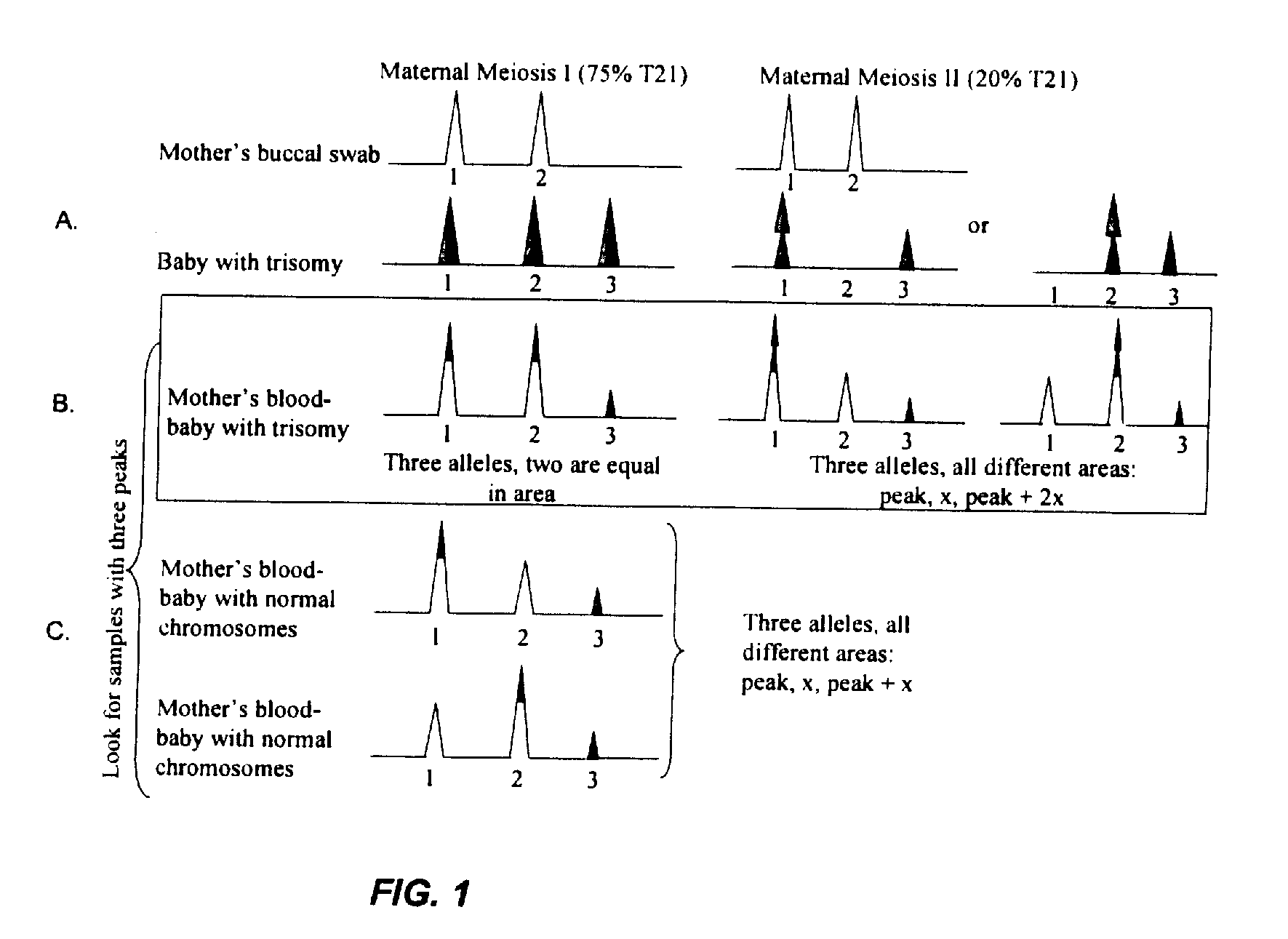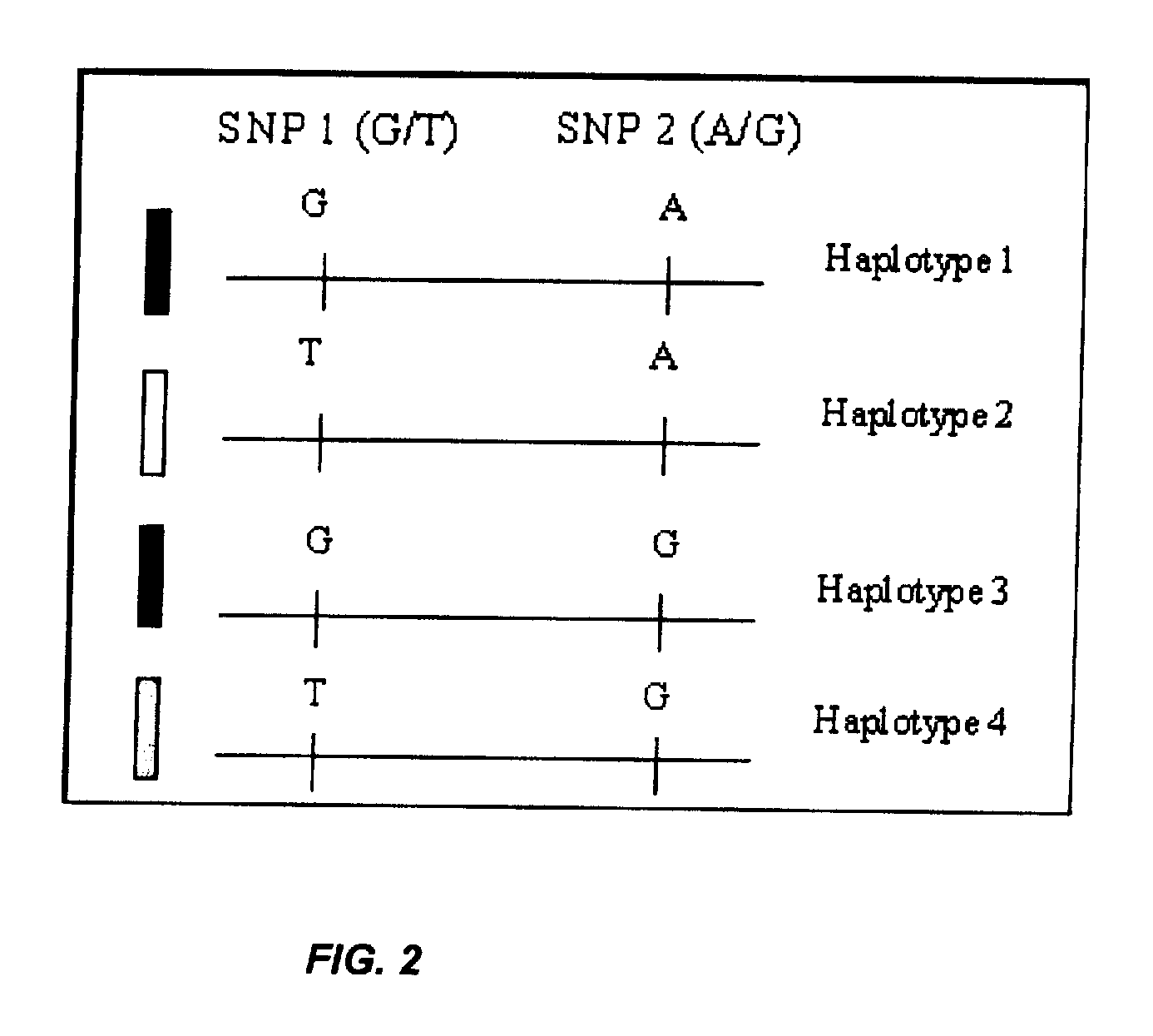Detecting Genetic Abnormalities
a technology of genetic abnormalities and detection methods, applied in the direction of microbiological testing/measurement, biochemistry apparatus and processes, etc., can solve the problems of individuals opting out, sensitivity and specificity of these common non-invasive screening tools are extremely poor
- Summary
- Abstract
- Description
- Claims
- Application Information
AI Technical Summary
Problems solved by technology
Method used
Image
Examples
example 1
Tandem SNPs for Chromosome 21
[0105]Allelic markers on chromosome 21 were selected by examining tandem SNPs. These tandem SNPs covered both q and p arms of the chromosome. Using heterozygosity data available through dbSNP, DCC Genotype Database and through the HapMap Project, SNPs that appeared to be promising for high heterozygosity (≧25%) were selected. Because all four possibilities may not exist in nature due to haplotype blocks in regions of low recombination, those that suggested less than three haplotypes were screened out.
[0106]Target sequences covering tandem SNPs were designed using Vector NTI and WinMelt software. As an example, the melting map of a CDCE or CTCE target covering two tandem SNPs (dbSNP rs2839416 and rs2839417) on chromosome 21 was calculated using WinMelt according to the algorithm of Lerman and Silverstein (Lerman et al., Methods Enzymol, 1987. 155: p. 482-501) and is depicted in FIG. 7.
[0107]FIG. 7 depicts a DNA melting map of a CDCE or CTCE target sequenc...
example 2
Determining Heterozygosity of Tandem SNPs
[0114]Genomic DNA samples from 300 anonymous subjects were obtained from healthy young adults who were less than 35 years old. The samples were anonymous as the only data obtained were the geographic location of the Red Cross blood donor center, donor gender, and whether or not the donor was 35 and under. These samples were reviewed to ensure that at least three haplotypes were present for a given target sequence of interest. These results were compared to haplotypes identified through analysis of the database from the HapMap project as described in Example 1, and it was found that the same or similar haplotypes were identified using both methods.
example 3
Detecting Fetal DNA in Maternal Serum
[0115]A cohort of subjects confirmed to have trisomy 21 by traditional karyotype analysis was examined. Tandem SNPs were used to demonstrate detection of trisomy in subjects. DNA from 20 subjects who were characterized by traditional karyotype analysis to have trisomy 21 were analyzed with the tandem SNP panel.
[0116]Biological samples, including a buccal (cheek) swab and a blood sample were collected from a cohort of pregnant women. Maternal buccal swab samples were compared to maternal serum to demonstrate that a third (paternal) peak was observed in several of the tandem SNP assays. Approximately 20 maternal buccal swab to maternal serum comparisons were made. To control for experimental artifacts, genomic DNA samples from maternal buccal swabs were utilized for each target sequence. The buccal samples were subjected to the process in parallel with the maternal blood sample. Any artifacts generated by the CDCE / CTCE / HiFi-PCR procedure (including...
PUM
| Property | Measurement | Unit |
|---|---|---|
| ultrasound test | aaaaa | aaaaa |
| DNA melting | aaaaa | aaaaa |
| capillary electrophoresis | aaaaa | aaaaa |
Abstract
Description
Claims
Application Information
 Login to View More
Login to View More - R&D
- Intellectual Property
- Life Sciences
- Materials
- Tech Scout
- Unparalleled Data Quality
- Higher Quality Content
- 60% Fewer Hallucinations
Browse by: Latest US Patents, China's latest patents, Technical Efficacy Thesaurus, Application Domain, Technology Topic, Popular Technical Reports.
© 2025 PatSnap. All rights reserved.Legal|Privacy policy|Modern Slavery Act Transparency Statement|Sitemap|About US| Contact US: help@patsnap.com



